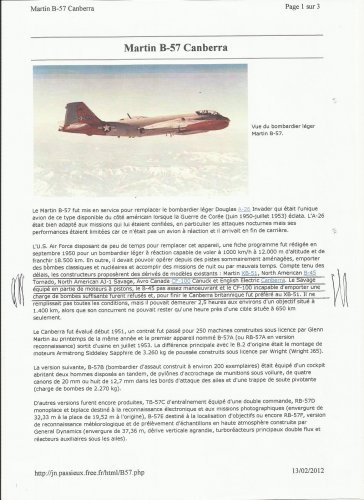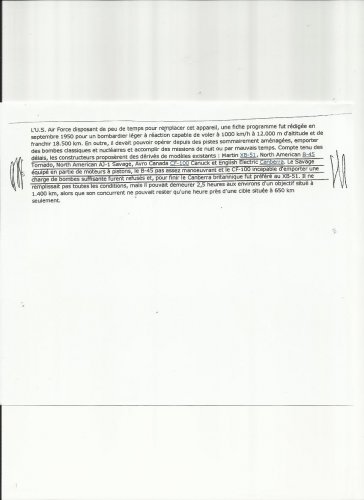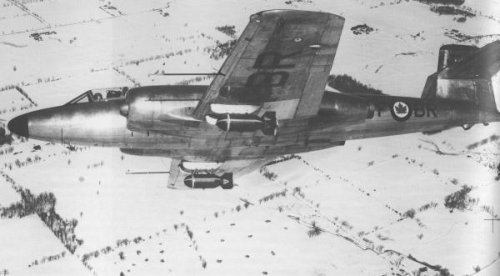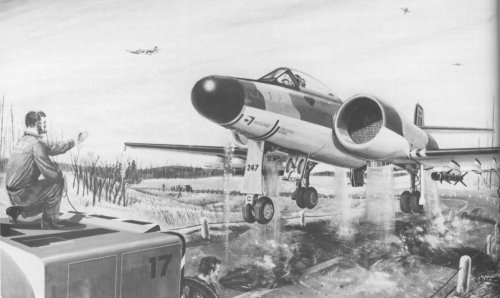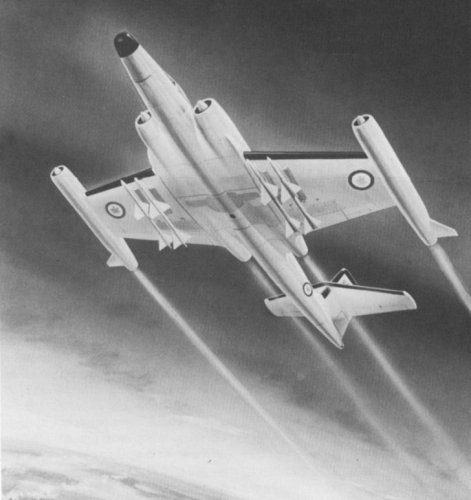An unusual CF-100 proposal originated from Avro's project research group in 1958. This group, headed by Mario Pesando, proposed an STOVL (Short Takeoff and Vertical Landing) CF-100 for use in the ground attack role. At the time NATO was becoming increasingly aware of the powerful Soviet tank force poised on its borders. Also at this time Hawker was beginning to work on the P.1127 V/STOL strike aircraft.
The Avro proposal was simple, as the basic CF-100 airframe was readily adaptable to short takeoff/vertical landing configuration. The fuselage-hugging engines were well placed for C of G needs. The long undercarriage provided ample ground clearance, and the wing had originally been designed to carry ordnance.
In part the description of this aircraft in the brochure reads: "From the start a short takeoff, vertical landing version of this aircraft was considered for a ground attack role only, with a considerable curtailment in range compared with that of the all weather interceptor fighter presently in service. ...To achieve a reasonable distance for clearing a fifty foot obstacle, a thrust weight ratio of at least 0.85 is required so that on the assumption of 12,000 lb installed thrust per engine being available, the aircraft weight should be trimmed down to 28,500 lb. ...The use of the present airframe will mean that although not representing the best possible structure in view of its early conception, the marriage of this aircraft with the BE 53/2 engines should result in the ground attack aircraft with the ability to operate out of and into relatively confined spaces, being available sooner than an aircraft designed from the start to have V/STOL capabilities. It is reasoned that a proven airframe is already available which should give Avro considerable lead time over Hawkers, assuming the engines will be available at the same time a delivery is available to Hawkers... Aircraft structural changes necessary to the installation of the BE 53/2 will include reworked forward and rear nacelles, and some modification of the centre section to accept the highly variable thrust (both magnitude and direction) will be necessary. In addition, the running of trimming nozzle ducting will be a considerable problem although the present hollow wing leading edge will reduce the magnitude of the work required. A sophisticated auto-pilot will be vital to successfull takeoff and landing since for much of the time in these phases the flying control surfaces will be thoroughly ineffective."
Weight savings of 8065 lb were anticipated from such measures as removal of the fire control system, the fuselage fuel system, the heavier Orenda engines, and the rear cockpit, and the shortening of the fuselage by four feet and of each wing by eight feet.
The proposal concluded that such a CF-100 would have its limitations,e.g. in range, but "as a research vehicle for investigation of the technique of short or vertical takeoff and landing autopilot performance and as a working model for acquiring acquaintance with the environment from which short and vertical takeoff aircraft can operate a CF-100 modfied in this manner would be valuable."
Avro saw little future in the STOVL CF-100. A company memo of the day commented, "The CF-100 STOVL vehicle is unlikely to be more than 12-18 months ahead of operational Hawker P.1127s since both projects are tied to the same engine time scale with first flight late in 1960. At 27,000/30,000 lb gross the CF-100 STOVL is a much bigger vehicle than NATO, for example, requires for the ground attack role... Moreover, the CF-100 STOVL, as presently exploited, does not appear to have any more capability than the P.1127 with which to justify the larger size. In some respects it does not equal the P.1127 capability."
The Avro proposal never left the drawing board. Meanwhile work at Hawker continued, the P.1127 making its maiden flight in October 1960. From it grew the successful series of Harrier strike aircraft.

